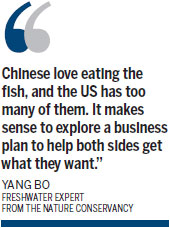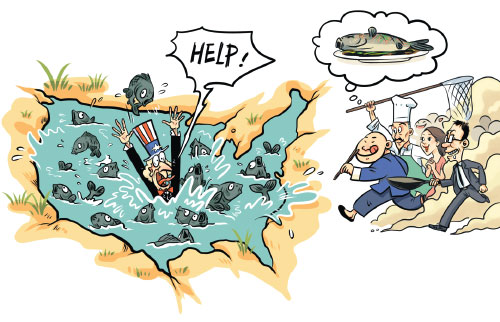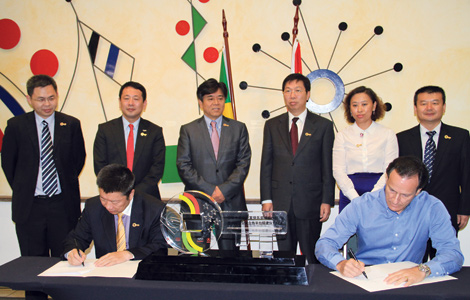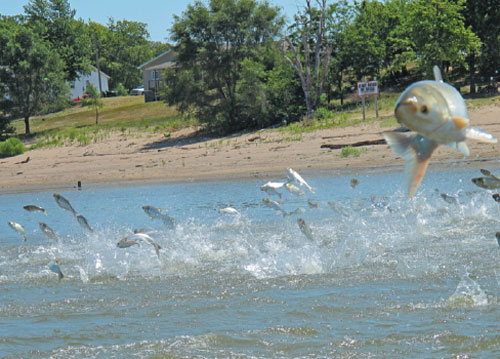Fishing for solutions
Updated: 2014-10-20 14:08
By Wang Qian(China Daily USA)
|
|||||||||
Businesses bank on Chinese palates to help rid US of invasive Asian carp, as Wang Qian reports.
For the past three years, John Jia has been getting dozens of calls every day asking about one of the most talked about products heading from the US to China - Asian carp.
Jia is one of the business liaisons for the Illinois-based Big River Fish Corp. The US company started exporting frozen Asian carp and fish products to China in 2005 and is expected to ride on a wave of growth. A processing factory is also being built in the Chinese port city of Tianjin to cater to its expansion.
"This is not only good news for Chinese consumers who will get wild fish to eat; it's also good news for the US because the Chinese are 'eating' the problems that are threatening US rivers," Jia said, smiling.
In the US, Asian carp - an aggressive invasive species - are making their way up the Mississippi River and its tributaries, threatening rivers and lakes. The fish is able to eat nearly 40 percent of its body weight every day and reproduce very quickly. Its spread can be disastrous for major waterways and water bodies like the Mississippi River and Great Lakes.
Asian carp were first introduced into the US from China in the 1970s to help enhance water quality in ponds.
The fish is considered a delicacy in China, and environmentalists have taken efforts to protect the species in the Yangtze River for years due to industrial pollution and the deteriorating water environment.
Getting more Chinese to eat the fish seems to be a win-win solution for the two countries and businessmen like Jia are making full use of the opportunity.
A sales manager of Shanghai-based Santa Food who refused to be named told China Daily in a telephone interview that the fish from the US is totally wild, tasting much better than the Chinese variety, which suffers from a poor water environment and excessive use of medication.
The company imported Asian carp products, including frozen fish and minced fillets, from Big River Fish starting late last year.
"Once clients try our products, they will come again," the manager said.
Even as Chinese businessmen rake in the profits from selling the Asian carp, a group of US scientists arrived in Shanghai, Wuhan and Chongqing in early September to search for solutions to prevent the spread of the fish in their country.
Yang Bo, a freshwater expert from The Nature Conservancy environmental organization, accompanied the group. Yang said one purpose of their visit is also to explore China's market for Asian carp.
They went to a seafood market in Shanghai and an aquatic product processing plant in Wuhan, and even tasted Chinese dishes made of Asian carp, she said.
"Chinese love eating the fish, and the US has too many of them. It makes sense to explore a business plan to help both sides get what they want," Yang said.
Entrepreneurs in China and US are increasingly aware of the economic opportunity. Big River Fish signed a contract in 2010 to export 13.6 million kilograms of Asian carp to the Beijing Zhuochen Livestock Husbandry company every year, according to the Ministry of Foreign Affairs website.
The business has a lot more room for expansion, Jia said.

Business obstacles
Still, Yang said there are many barriers to making the business sustainable and large scale.
These include the high cost of transportation, tariffs and the Asian Carp Prevention and Control Act, a US law that makes transporting live fish across US state boundaries illegal.
Jim Garvey, director of the Fisheries and Aquaculture Center at Southern Illinois University Carbondale, who was part of the visit, said he hopes that research and collaboration between the US and China will lead to greater demand for the fish and enhanced economic opportunity.
Garvey admitted that exporting the products to China and other countries has proved to be difficult because of the economics of shipping and lack of clear demand abroad.
For Sun Shihu, sales manager of the Qingdao Oceanfriends IMP and EXP in Shandong province, these barriers are actually making its Asian carp business unprofitable.
Sun's company started selling the frozen fish imported from the US in 2013 at a price of about 9,500 yuan ($1,560) a metric ton to 11,000 yuan a ton.
"The sales record is really bad because the price is higher than clients' expectation," Sun said.
Besides the higher price, Sun said, Chinese like to buy live fish for cooking, and the frozen ones are not well accepted in the market.
As US law does not allow live fish to be transported across state borders, only frozen fish or fish products can be exported.
The sales manager in Shanghai agreed and said it will take time for Chinese consumers to accept dishes made of frozen fish.
He admitted that the sale of the fish products is not satisfactory yet but he remained optimistic about the business.
For Jia, his company has a special way to "guarantee the best taste for frozen fish".
"After the fish is netted, it will be frozen alive immediately under-28 C. Within 24 hours, the fish will be cut into pieces, put in low-temperature containers and transported by ship," Jia said. The fish will arrive in Tianjin within three weeks, he said.
Besides selling frozen fish, Jia said a processing plant will also be built to produce fish balls, patties and canned food to meet the diversified demand.
"The fish meat tastes better than the fish in China because the water is cleaner in the US and the fish is 100 percent wild and organic," Jia said.
Sourcing solutions
Eating Asian carp is only one way to prevent its spread in US rivers. The US government has spent hundreds of millions of dollars to fight the scourge, including the use of electric barriers, water guns and scent-based lures.
Garvey said the US government has spent nearly $100 million on research in the past four decades to determine ways to impede movement and reduce carp density in rivers.
He expressed worries that the Asian carp will eat freshwater mussels into extinction. The US has the highest diversity of freshwater mussels in the world.
In January, a plan to physically separate the waterway link between the Illinois River and the Great Lakes was unveiled. The move is expected to cost $18 billion and take decades to implement.
There is no guarantee that the permanent separation will become the key way to prevent any interchange between the water systems, Garvey said.
Scientists in the US and China are also strengthening cooperation to study the fish, including the impact of water temperature and flow on its breeding, to seek effective ways to control fish reproduction, Yang said.
In October or November, Chinese scientists will visit the US to further study the fish with US scientists, she said.
Garvey said the US has much to learn from the expertise of Chinese scientists, resource managers, businesspeople and fishermen, and he hopes that the exchange of knowledge on both sides will lead to discoveries that help the US control Asian carp and for China to help recover the species in the Yangtze River.
Yang agreed that the cooperation can help China protect the Yangtze River and recover the fish species.
Amid the increasing construction of hydropower dams of the past decades, overfishing and industrial and agricultural pollution, a report on the Yangtze River jointly conducted by the Ministry of Agriculture and World Wide Fund for Nature last year showed that the ecosystem of the upper river is on the verge of collapse.
Zhao Yimin, head of the Yangtze River Fishery Resources Committee under the Ministry of Agriculture, said in a previous interview that China's fishery resources will be drained soon if no immediate and effective action is taken.
For Jia, compared with the use of "expensive research and technology" to save the rivers in the US and China, delivering Asian carp to Chinese dinner tables is the "fast and cheap" way.
Contact the writer at wangqian@chinadaily.com.cn

|
This June 13, 2012, photo shows Asian carp, jolted by an electric current from a research boat, jumping from the Illinois River near Havana, Illinois. Scientists at a network of field stations on the Mississippi and Illinois rivers are using electric currents to stun fish so they can be collected and examined. Associated Press |
(China Daily USA 10/13/2014 page6)

 10th International Shaolin Wushu Festival opens
10th International Shaolin Wushu Festival opens
 What they say - Frontline staff in the battle against Ebola
What they say - Frontline staff in the battle against Ebola
 Biz clubs deepen cooperation
Biz clubs deepen cooperation
 Beijing marathon concludes in smog
Beijing marathon concludes in smog Highlights of Shanghai Fashion Week
Highlights of Shanghai Fashion Week
 Yang, Kerry meet in Boston ahead of APEC
Yang, Kerry meet in Boston ahead of APEC
 Writer Lu Xun's works honored in NY
Writer Lu Xun's works honored in NY
 Huawei exhibits products in Brazil
Huawei exhibits products in Brazil
Most Viewed
Editor's Picks

|

|

|

|

|

|
Today's Top News
College football touches down to China
China-US cyber security talks hard to resume
Alibaba joins global shipping effort
Biz clubs deepen cooperation
Brazil needs its own version of China Dream, expert says
Latin America infrastructure needs more investment
Runners resort to face masks
Support dwindling for HK protesters
US Weekly

|

|









